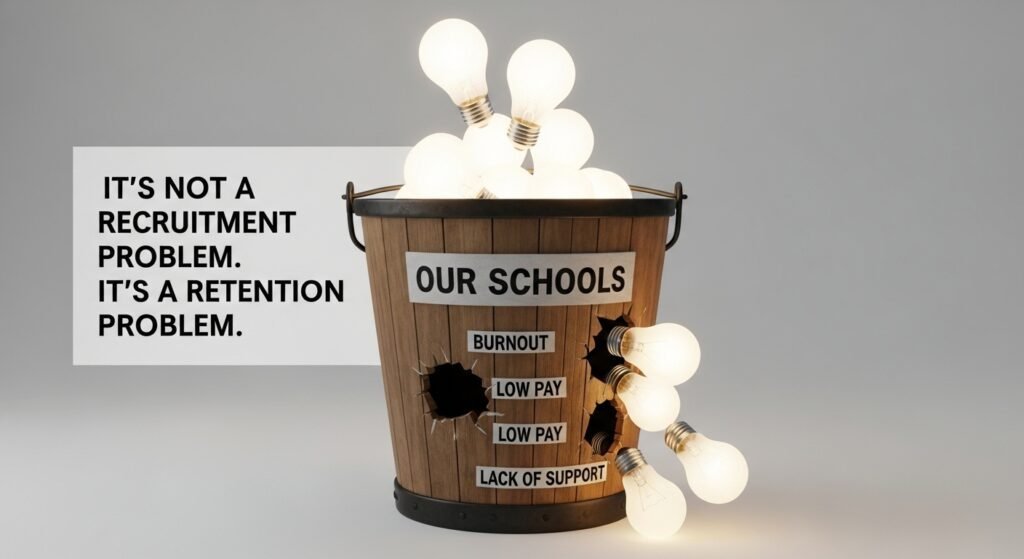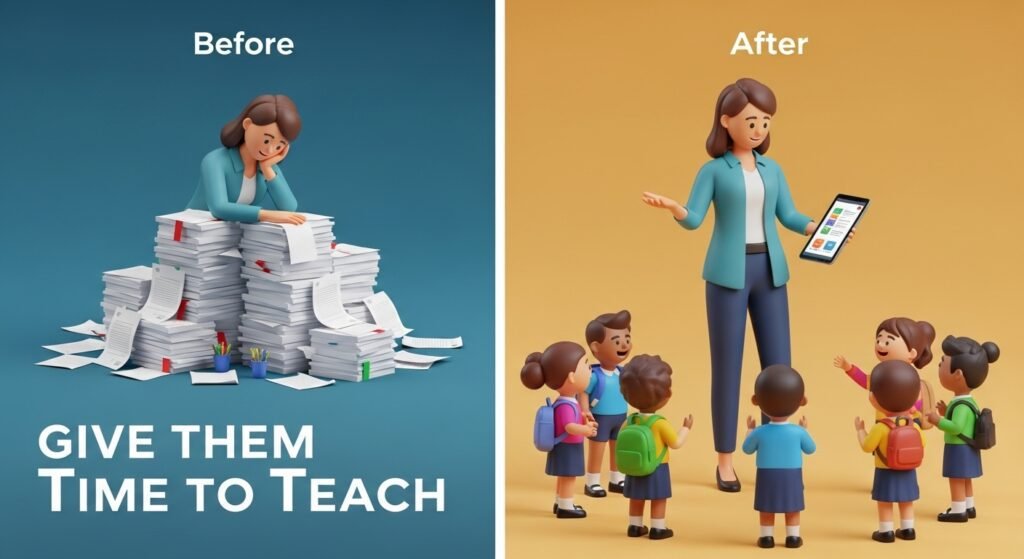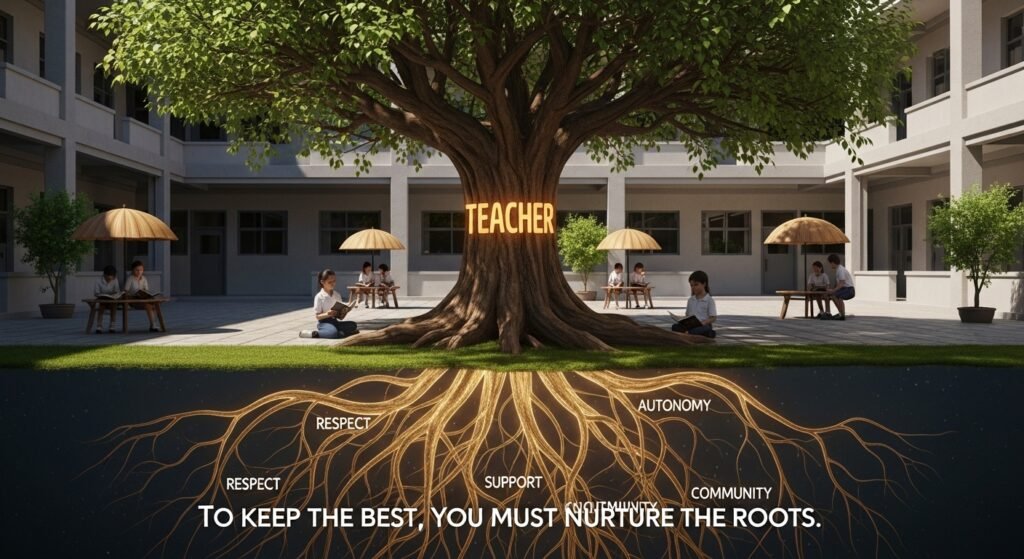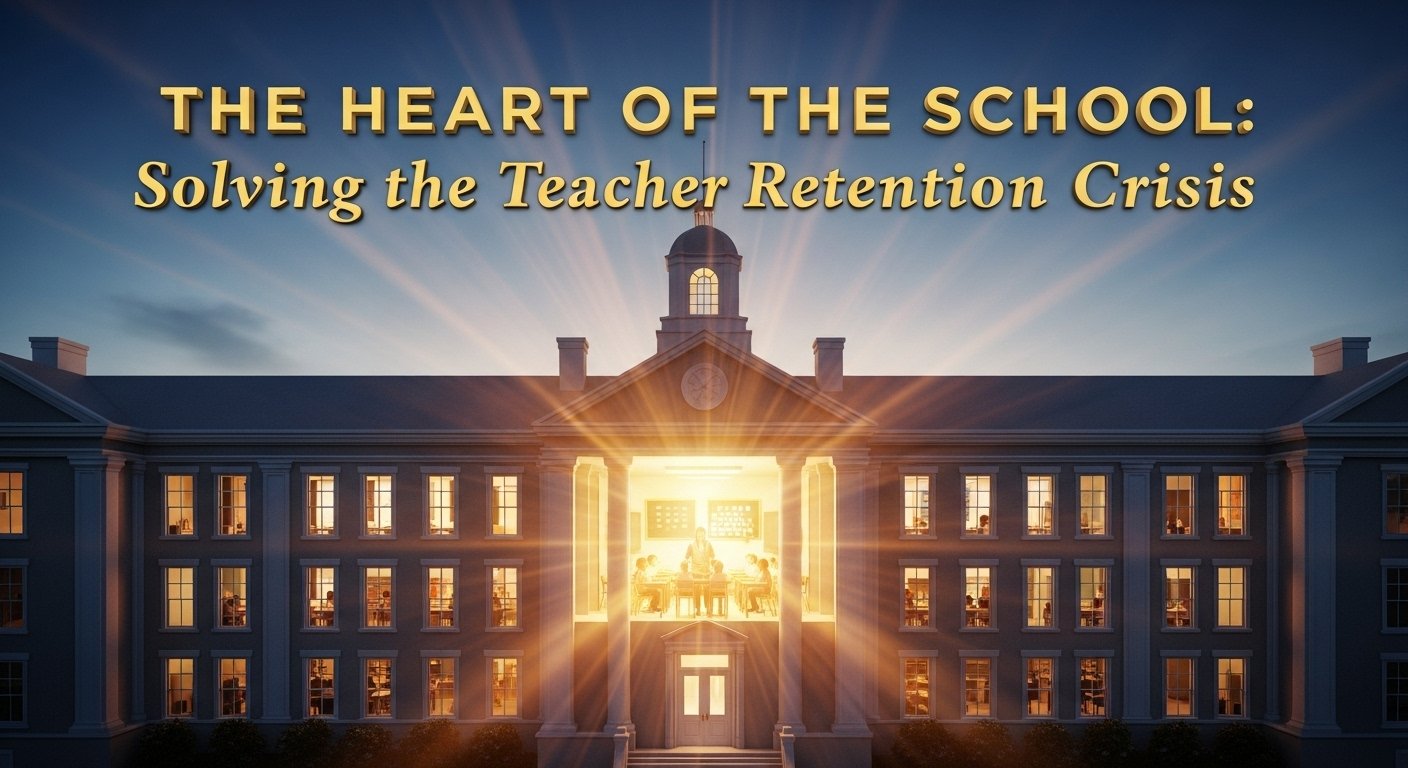The Heart of the School: Why Teacher Retention is the Most Important Conversation in Education
I still remember Mr. Evans, my high school history teacher. He didn’t just teach dates and battles; he taught us how to think. He’d turn a dry chapter on constitutional law into a passionate courtroom debate that had the whole class on the edge of their seats. He was the kind of teacher who changes lives. In my third year of university, I learned he had quit teaching to go into corporate training. The reason? Burnout. A brilliant, irreplaceable educator was lost, and I remember thinking, “What a waste.” This quiet, personal loss, repeated in thousands of schools every year, is the human face of the teacher retention crisis.
As we navigate the educational landscape of 2025, we are facing a critical challenge that underpins every other conversation about student success. It’s not about new curricula or fancy technology; it’s about the people. The teacher retention crisis is the “leaky bucket” of our education system—we can keep pouring in new recruits, but if we don’t fix the holes that are causing our best and brightest to leave, we will never achieve our goals. As an educator and tech enthusiast at PaidScripts.com, I’ve seen both the challenges and the innovative solutions firsthand. It’s time to move beyond simply admiring the problem and focus on the practical, systemic solutions that can make teaching a sustainable and joyful profession once again.

The “Leaky Bucket” Problem: Understanding the Scale of the Crisis
For years, the conversation around teacher shortages has focused on recruitment. But the data tells a different, more alarming story. The real issue isn’t just that not enough people are entering the profession; it’s that far too many are leaving, especially within their first five years.
According to research from organisations like the Learning Policy Institute, teacher turnover rates in the US are significantly higher than in many other high-achieving countries. This constant churn has profound consequences:
- It destabilises the school environment and disrupts student learning.
- It drains financial resources, as districts spend millions on recruiting and training replacements.
- It leads to a loss of invaluable experience and institutional knowledge.
Simply put, a school cannot be great without great, experienced teachers who are committed to their students and their community for the long haul. Solving this requires a fundamental shift in how we think about supporting our educators, a shift that is at the heart of improving teacher retention.
Reactive vs. Proactive Support: A Fundamental Shift in Thinking
For too long, school districts have taken a reactive approach to teacher turnover. They wait for a teacher to resign, then scramble to fill the position, sometimes offering a one-time bonus as a temporary fix. A proactive approach, however, focuses on creating an environment where teachers never want to leave in the first place.
| Reactive Measures (The “Sticking Plaster” Approach) | Proactive Solutions (The “Sustainable System” Approach) |
| Focus: Filling empty positions as quickly as possible. | Focus: Creating a culture and environment that retains talent. |
| Timing: Happens after a teacher resigns. | Timing: Happens continuously throughout a teacher’s career. |
| Tools: Signing bonuses, last-minute recruitment fairs. | Tools: High-quality mentorship, collaborative planning time, mental health support. |
| Goal: Short-term problem solving (get a body in the classroom). | Goal: Long-term professional sustainability and growth. |
| Message Sent: “Teachers are replaceable.” | Message Sent: “Teachers are invaluable professionals.” |
4 Characteristics of Warm Demander Teachers | Balancing Care & High Expectations
Beyond the Paycheque: The Real Reasons Teachers Leave (and How to Make Them Stay)
While fair compensation is undeniably important, research consistently shows that teachers leave the profession for reasons that go far beyond their salary. They leave because the daily realities of the job have become unsustainable. Addressing the teacher retention crisis means tackling these core challenges head-on.

Challenge 1: The Crushing Workload and Lack of Time
The Reality: Teachers are drowning in a sea of administrative tasks, grading, parent communication, and ever-changing initiatives. The one thing they lack is the most precious resource of all: time. Time to plan thoughtful lessons, time to collaborate with colleagues, and time to simply breathe.
The Solution: Give Them Back Their Time.
- Protect Planning Time: Schools that prioritise teacher retention fiercely protect collaborative planning time. This is not a “free period”; it’s sacred time for teams of teachers to design lessons, analyse student data, and support one another.
- Embrace Technology Thoughtfully: As a tech enthusiast, I know technology can be a double-edged sword. However, AI-powered tools are now mature enough to be incredible time-savers. AI can help draft lesson plans, create differentiated materials, and automate the grading of simple assignments, freeing up teachers to focus on high-impact instruction and student relationships.
- Fight “Initiative Overload”: School leaders must act as a filter, protecting their staff from the constant churn of new, district-wide initiatives. Focus on doing a few things well, rather than doing many things poorly.
Challenge 2: Lack of Professional Autonomy and Respect
The Reality: Many talented teachers feel more like technicians than professionals. They are handed a scripted curriculum and a rigid pacing guide and are given little to no voice in the decisions that affect their classrooms and their school.
The Solution: Trust Your Teachers.
- Involve Them in Decision-Making: Create meaningful opportunities for teachers to participate in school governance, curriculum selection, and the development of school policies. When teachers have a voice, they have a sense of ownership.
- Encourage Professional Judgment: Move away from rigid, top-down mandates. Trust your teachers to make professional decisions based on the unique needs of the students in front of them. This culture of trust is a powerful driver of teacher retention.
4 Characteristics of Warm Demander Teachers | Balancing Care & High Expectations

Challenge 3: The “Sink or Swim” Mentality for New Teachers
The Reality: The first few years of teaching are incredibly challenging. Yet, we often hand new teachers the most difficult assignments with the least amount of support, and then act surprised when they leave.
The Solution: Build a World-Class Mentorship Programme.
- Sustained, High-Quality Mentoring: A one-day orientation is not enough. Effective induction involves pairing a new teacher with a skilled, experienced mentor for at least two years. This relationship should involve regular, non-evaluative observations, co-planning, and confidential support.
- Provide Resources, Not Just a Buddy: Mentors need to be properly trained and compensated for their time. New teachers need a reduced course load in their first year to allow them time for observation and professional development.
Challenge 4: The Unseen Mental and Emotional Toll
The Reality: Teaching is an act of profound emotional labour. Teachers are not just instructors; they are counselors, social workers, and cheerleaders. The constant emotional output, combined with high stress, leads to staggering rates of burnout. A focus on teacher retention must include a focus on teacher well-being.
The Solution: Make Teacher Mental Health a Priority.
- Accessible Support: Schools should provide free, confidential, and easily accessible mental health resources specifically for their staff.
- Foster a Culture of Well-Being: Leadership must actively model and encourage a healthy work-life balance. This means respecting contract hours, discouraging the expectation of answering emails at all hours, and creating a culture where it’s okay to admit you’re not okay.
5 Tips for Welcoming Classroom Visitors
A Personal Insight: The Teacher Who Almost Quit
I once had the privilege of mentoring a brilliant first-year teacher, “Ms. Diaz.” She had all the raw talent in the world—a deep passion for her subject and a natural ability to connect with students. But by November, she was on the verge of quitting. She was working 70-hour weeks, felt completely isolated, and was convinced she was failing.
Her principal, a wise veteran, noticed the signs. She didn’t put her on an improvement plan; she put her on a support plan. She connected Ms. Diaz with a master teacher in the building to co-plan with, she used school funds to pay for a substitute for two days so Ms. Diaz could simply observe other classrooms, and she made a point of stopping by her room every week just to ask, “How are you, really?”
That small, human investment made all the difference. It showed Ms. Diaz that she was valued, that her struggle was normal, and that she was part of a team. She stayed. Today, she is one of the most beloved and effective teachers in the school. We didn’t save a first-year teacher; we saved a 20-year career. That is the power of proactive teacher retention.

Conclusion: The Heart of the School is the Teacher
Solving the teacher retention crisis is not about finding one magical programme or a single, simple fix. It is about a fundamental commitment to building a professional culture of respect, support, and sustainability in our schools. It’s about recognising that the working conditions for our teachers are the learning conditions for our students.
When we invest in giving our teachers the time, trust, support, and care they need to thrive, we are making the single most important investment we can in our children’s future. The heart of every great school is not its building or its curriculum; it’s its dedicated, passionate, and experienced teachers. It’s time we did everything in our power to keep them there.
What is one thing your school does (or could do) to truly support its teachers? Share your experiences and ideas in the comments below!



